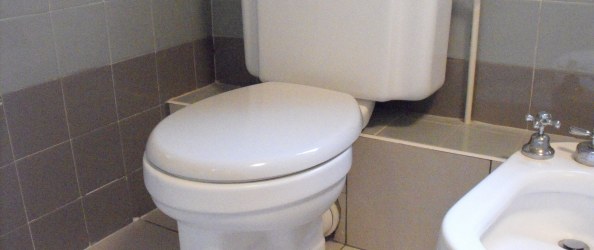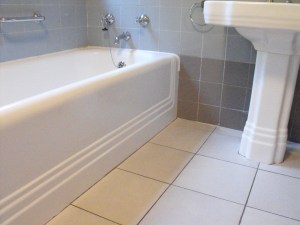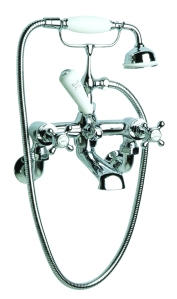Tips on Cleaning Your Bathroom

Most of us like to think of our bathrooms as a luxurious haven we can escape to, even if only rarely. It’s the room we want to have a lovely long soak in and relax after a stressful or busy day. For us to get the most enjoyment from our bathrooms it is essential that they are clean.
First of all make sure you have all the cleaning materials and equipment you will need. There’s nothing more irritating than having to run up and downstairs getting another cloth etc. It’s a good idea to get a little box with everything you’ll need prepared beforehand for each time you need to do the job. If you live in a house with more than one bathroom you can have a small box of cleaning liquids and cloths etc in each bathroom. Bring the large equipment such as Hoovers, mops etc to the bathroom.
Dust down the corners, ceiling, top of cabinets etc. You may need a set of step ladders to reach. Dust any fans or vents. If these have been neglected you may need to give them a scrub with a liquid bathroom cleaner and a cloth. Once up to scratch though they are easy to keep clean.
Get rid of any laundry or empty toothpaste tubes etc. Clear the bathroom of rubbish and nick- knacks to make your job easier.
Bathroom rugs can be shaken out or put in the laundry. If you have a shower curtain this can also be taken down to be washed and put in the laundry. It should be put back up immediately afterwards to dry. The shower curtain can’t be tumble dried. Then spray a general bathroom cleaner on counter tops. Once you have sprayed the bath, toilet etc you can start wiping the surfaces down with a cloth.
If you have an original Victorian cast iron bath be very careful what cleaner you use. Many are not suitable for enamel and will eat and erode the surface. In fact we end up restoring these baths frequently. With original cast iron baths it’s best not to leave any cleaner on it for any length of time. Apply the cleaner and wipe the bath down right away. Otherwise the cleaner may react and your bath will be damaged very quickly.
A general liquid bathroom cleaner is normally very good for all types of baths. Cast iron, Acrylic etc. This kind of cleaner can also be used on sinks, shower trays etc. Don’t use any cleaners that have abrasive particles in them as these can scratch your bath and over time you will begin to find the bath is harder and harder to clean. If in doubt some warm water, washing up liquid and a good bit of elbow grease will suffice.
If you live in a hard water area then your sanitary wear can be affected by limescale. The limescale can build up causing damage to your bath or wash hand basin as well as leave unsightly marks. Often the damage is such that the only way to resolve the issue is to have The Bath Business come in and resurface your bath and/or wash hand basin. However, once your bath or bathroom suite has been restored by The Bath Business there are some things you can do to avoid limescale building up again.
Sometimes a bath is positioned in such a way that not all the water can drain away from it and there is always a little puddle around the plug hole or waste. In you suffer from limescale then this area will become affected. It may be worth getting a plumber in to re align the bath. If this is not possible as the bath is a solid cast iron bath or moving it would cause redecorating issues the problem can still be resolved.
The first thing you should do when you have finished taking a bath or finished using your wash basin is dry it. Lime-scale deposits come to settle in the bath or basin once the water has evaporated off. If you rinse your bath or basin after using and dry them the limescale will get wiped up with the water rather than being left in the bath to settle.
This can help avoid limescale deposits but inevitably sometimes you may forget, or you have a guest staying over or your teenage son/husband can’t see the point in all this work after a nice long bath. So you may still get some limescale building up on the bath or sink despite your best efforts. The best thing to do in this instance is to dab on white vinegar to the affected area. The vinegar will react with the limescale without destroying the enamel.
Vinegar is a very handy cleaning agent.
If you ever find your cistern or vanity unit seems to suffer from condensation after anyone has had a bath or shower in the room you can use vinegar to resolve this. Put 2/3 water and 1/3 vinegar solution in a spray bottle and spray over your cistern etc and wipe down with a cloth. Next time someone has a shower the condensation should not affect the sprayed area.
How about bathroom mirrors? They inevitably get marked or can look streaky. Vinegar comes up trumps again. The following solution works wonders with bathroom mirrors. If you feel in the mood you can always use this solution on other mirrors or your windows in your home as well.
- Pour Vinegar into a bowl or pan, then crumple a sheet of newspaper and dip it in the vinegar. Apply to the mirror.Wipe the glass several times with the same newspaper until the mirror is almost dry. Then shine it with a clean soft cloth or dry newspaper.
Something in the ink seems to help create a really nice shine on the glass. However wear gloves or your hands will be covered in ink!
As with most cleaning prevention is better than cure. Rather than letting dirt or grim build up it is best to deal with it as you go along. Fortunately bathrooms do tend to have tiles or flooring that is very easy to keep clean if grim is not allowed to build up on them. There are sprays you can purchase which are very good for glass shower screens. If sprayed after each use, mildew etc can be avoided. Some people keep old toothbrushes to help clean tricky areas in the bathroom. These are very good for getting into shower heads and such. However if you have young children it’s probably best not to use these in case one of your youngsters picks up the wrong toothbrush. If everyone in your home rinsed down the bath, sprays the shower screen etc after each use then rather than having to clean the bathroom on a daily basis you may well be able to do one big clean in a week. Off course if you have a bathroom that is used extensively by a lot of people you may not be able to avoid daily cleaning. It’s still worth making sure everyone does clean down the bath etc after each use. At least then your job of cleaning will be made much easier.
How To Clean A Shower Head
The most eco-friendly approach involves the use of vinegar again. Soak the shower head (removed) in a solution of half distilled vinegar and half water for a couple of hours. Afterwards, rinse thoroughly.
Or, use a liquid descaler and an old toothbrush. If you live in a hard water area, you may have to do this job regularly.
As always, do a test patch first to check that your shower head will not be damaged by chemicals.
How To Clean Taps
It’s worth bearing in mind that some taps, particularly those with gold or brass finishes will be damaged by a build-up of toothpaste. If you can wipe and dry the taps after every use that is ideal. However as discussed previously some family members or guests may not be expected to do this or simply just forget.
The best solution is to clean regularly with a solution of washing up liquid, rinse and dry. Do not use an abrasive cleaner on taps. If you need to remove limescale you can try dabbing on the white vinegar again. You might need to scrub the limescale off with but the vinegar does help break the limescale down and dislodge it. Or you can soak a cloth in a descaler and wrap it round the taps. Do not leave for longer than the manufacturer recommends or your taps could be damaged, and always do a test patch first if you’re not sure. Once finished, rinse thoroughly and dry. Another good way of dealing with limescale on taps is to put lemon juice in a spray bottle. Squirt your taps once a week to help deal with and prevent limescale. An added benefit is the lemon smell is quite nice .
How To Clean The Toilet
Regularly wipe down the toilet seat with a solution of mild bathroom cleaner or washing up liquid. Don’t forget to clean the outside of the bowl and the cistern on a regular basis also.
You can add a toilet cleaner, normally in the form of a hard block, into the cistern to help clean the bowl. Check with the manufacturer. Some modern toilets have fittings within the cistern that corrodes with these cleaners. If the manufacturer says it’s okay to use these type of cleaners in the toilet then this will clean the toilet to some degree with every flush.
For thorough bowl cleaning, use a toilet brush, not forgetting to scrub under the rim. Rinse the brush with bleach afterwards, and flush the loo over it to clean it off. Some people prefer disposable toilet brush cleaners so once you’ve finished scrubbing you simply flush the brush away.
If your loo has built up limescale this can be really unsightly. It is possible to remove this. Sometimes it is a matter of draining the toilet down and applying vinegar or another limescale remover to the affected areas and scrubbing it off. Once done however just make sure you keep the loo clean and use cleaners with limescale remover if necessary to prevent build up again.
Another thing you can try if your toilet has reached the unsightly stage is pouring a can of Cola into the pan and leaving it over night. Flush away in the morning. Slightly worrying how effective this popular drink is at cleaning.
My favorite trick for cleaning the toilet are denture tablets. Put one in the bowl and one in the cistern. Leave for 1 hour and flush. You’ll have a sparkling toilet in no time!
Using more than one toilet cleaner at a time will release toxic gases so don’t try that.
The last things you should do is sweep or Hoover the floor and then mop your bathroom floor.
Let us know any tips on cleaning the bathroom you’ve found useful. We might include them in our blog!





 Add us to your circle
Add us to your circle